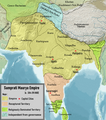File:Samprati Maurya Empire.png

Original file (659 × 746 pixels, file size: 653 KB, MIME type: image/png)
| This is a file from the Wikimedia Commons. Information from its description page there is shown below. Commons is a freely licensed media file repository. You can help. |
Summary
| DescriptionSamprati Maurya Empire.png |
English: Samprati Maurya Empire
Smith, Vincent Arthur; Edwardes, S. M. (Stephen Meredyth) (1924). The early history of India : from 600 B.C. to the Muhammadan conquest, including the invasion of Alexander the Great. Robarts - University of Toronto. Oxford : Clarendon Press.
Asiatic Society (Calcutta, India) (1832). Journal of the Asiatic Society of Bengal. Missouri Botanical Garden. Calcutta : Asiatic Society
Beni Madhab Barua (1946). Asoka And His Inscriptionns
The Cambridge History Of India Vol.I by E. J. Rapson.
An archaeological history of religions of Indian Asia by Jack Finegan.
The Archeology of World Religions by Jack Finegan.
|
| Date | |
| Source | Own work and map created from DEMIS Mapserver, which are public domain. |
| Author | Levakpitam |
Licensing
| This file is made available under the Creative Commons CC0 1.0 Universal Public Domain Dedication. | |
| The person who associated a work with this deed has dedicated the work to the public domain by waiving all of their rights to the work worldwide under copyright law, including all related and neighboring rights, to the extent allowed by law. You can copy, modify, distribute and perform the work, even for commercial purposes, all without asking permission.
http://creativecommons.org/publicdomain/zero/1.0/deed.enCC0Creative Commons Zero, Public Domain Dedicationfalsefalse |
References
- ↑ Smith, Vincent Arthur; Robarts - University of Toronto (1924) The early history of India : from 600 B.C. to the Muhammadan conquest, including the invasion of Alexander the Great, Oxford : Clarendon Press, p. 202
- ↑ Smith, Vincent Arthur; Robarts - University of Toronto (1924) The early history of India : from 600 B.C. to the Muhammadan conquest, including the invasion of Alexander the Great, Oxford : Clarendon Press, p. 458
- ↑ Asiatic Society (Calcutta, India); Missouri Botanical Garden (1832) Journal of the Asiatic Society of Bengal., Calcutta : Asiatic Society,
- ↑ Beni Madhab Barua (1946) Asoka And His Inscriptionns, p. 58
- ↑ Rapson, E. J. (1935) The Cambridge History Of India Vol.i, p. 512
- ↑ Finegan, Jack; Internet Archive (1989) An archaeological history of religions of Indian Asia, New York : Paragon House, p. 115 ISBN: 978-0-913729-43-4.
- ↑ Finegan, Jack; Internet Archive (1952) The Archeology of World Religions, p. 219
- ↑ Sharma, S. r (1940) Jainism And Karnataka Culture, p. 130
Captions
some value
8 December 2023
image/png
File history
Click on a date/time to view the file as it appeared at that time.
| Date/Time | Thumbnail | Dimensions | User | Comment | |
|---|---|---|---|---|---|
| current | 00:19, 19 May 2024 |  | 659 × 746 (653 KB) | Levakpitam | minor correction |
| 23:16, 8 December 2023 |  | 659 × 746 (654 KB) | Levakpitam | Uploaded own work with UploadWizard |
File usage
The following page uses this file:
Global file usage
The following other wikis use this file:
- Usage on hi.wikipedia.org
- Usage on ne.wikipedia.org
- Usage on simple.wikipedia.org
Metadata
This file contains additional information, probably added from the digital camera or scanner used to create or digitize it.
If the file has been modified from its original state, some details may not fully reflect the modified file.
| Horizontal resolution | 37.79 dpc |
|---|---|
| Vertical resolution | 37.79 dpc |
